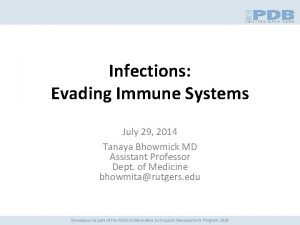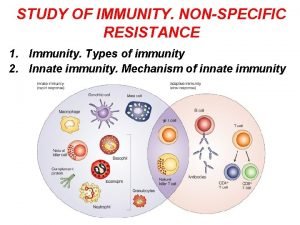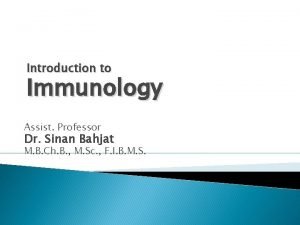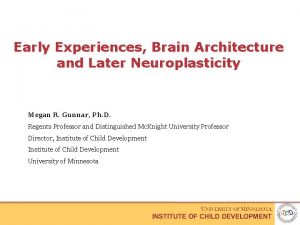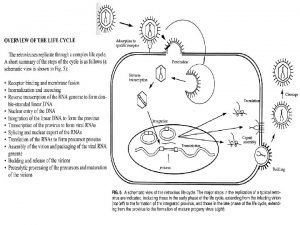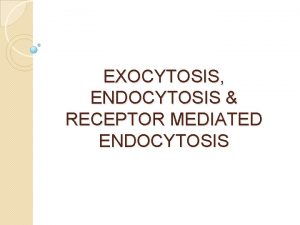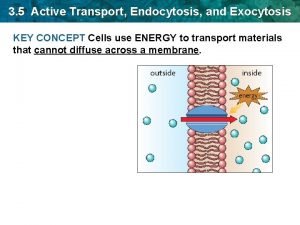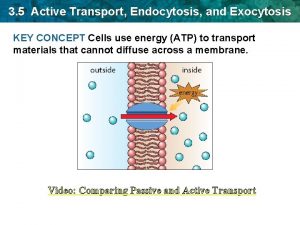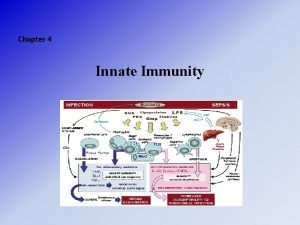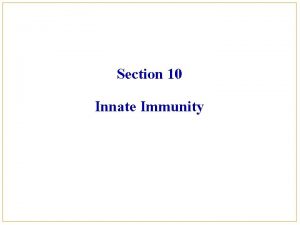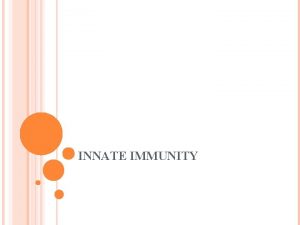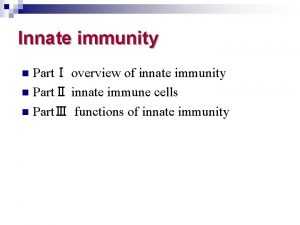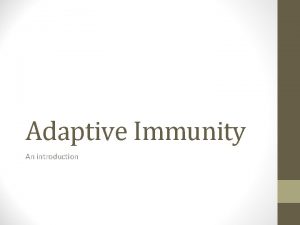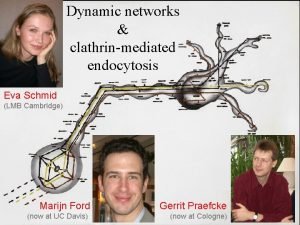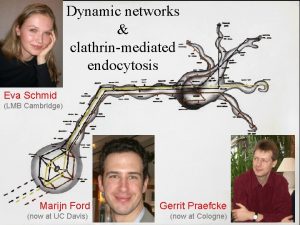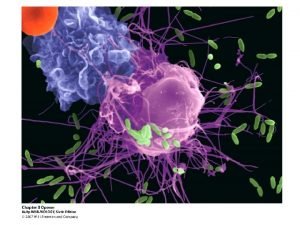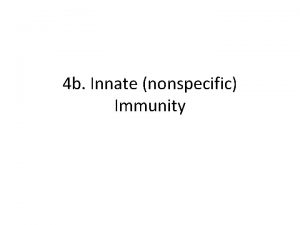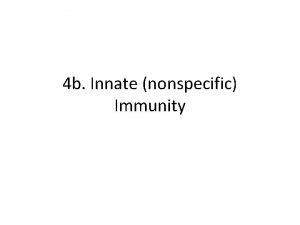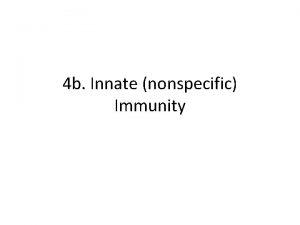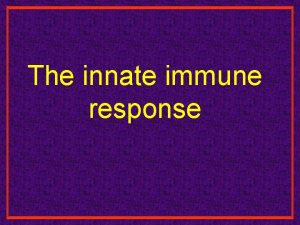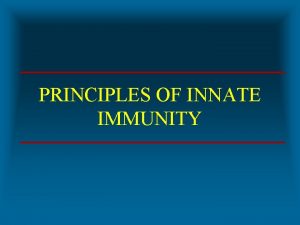Innate Immunity Review on your own Clathrinmediated endocytosis

















- Slides: 17

Innate Immunity Review on your own: Clathrin-mediated endocytosis Endomembrane transport system Also review slides on innate immunity in previous ppt Note about the alternative pathway of Complement: You are not responsible for knowing the specific steps that are unique to this pathway. Self-Test Questions: A: both B 1: all B 2 -3: 1 - 6, 9 B 4: 1 - 4 B 5: 1 - 5 B 6: 1 Innate Immunity 1

What is inflammation? An Innate response involves cellular & physiological elements Localized Redness (erythrema) -- Capillary vasodilation Swelling (edema) -- Capillary vasopermeation Pain –Nerve pressure (swelling) , damage Heat Loss of function Systemic -- infection only Fever Increase in WBC Changes in serum proteins -- e. g. , Acute phase proteins Diagnostic for infection Innate Immunity 2

“Danger signals” activate innate cells Some Danger Signals (See Table 3 -1 & Table 7 -3) “Danger signals” = PAMPs “Pathogen-associated molecular patterns” -- molecules of pathogens or wounding -- general structure/widespread occurrence PAMPS bind to Receptors called PRRs “Pattern Recognition Receptor” Viral ds. RNA Viral ss. RNA Bacterial LPS, flagellin, pilin Bacteral and fungal cell wall components Microbial polysaccharides Reactive oxygen molecules H 202, OH-, O 2 Certain cellular molecules -- e. g. , “Toll-like receptors” (TLR) -- other types also Very important to DC activation -- upregulates MHC expression -- allows T-cell activation Innate Immunity 3

Danger signals trigger an “anti-viral” state Which can be disabled by many viruses Cell destruction also releases new warning signals Innate Immunity 4

Clinical presentation of the innate response Acute Phase Response immune cells appetite fever lethargy etc. Δ Acute Phase Proteins C-reactive protein -- removal of dead cells Ferritin, Hepcidin -- bind iron Complement proteins -- attack pathogens Coagulation proteins -- enhance blood clotting Etc. Innate Immunity 5

Sedimentation rate, Black bile & Medieval blood letting Fibrinogen & Rouleaux = “Black bile” Rouleaux Innate Immunity 6

Chronic inflammation causes tissue damage, disorders and cancer Liver, colon, and stomach cancer arteriosclerosis Tuberculosis Consequence of “collateral” damage by secreted enzymes and oxidative chemicals Innate Immunity 7

Helicobacter pylori and peptic ulcers causes 60 -80% of stomach ulcers 90% doudenal ulcers Stomach cancers Innate Immunity 8

What is complement? What are the 4 principal functions of complement? Innate Immunity 9

Complement involves a “proteolytic activation cascade” C 1 activates C 4, which activates C 2 … to C 9 What are the 3 pathways of initiation? Classical (acquired) -- initiated by Ab bound to AG C 3 Alternative (innate) -- does not involve Ab binding Lectin (innate) -- activated by mannose-binding lectin Innate Immunity 10

The Classical Pathway involves 3 stages Initiation begins with C 1 binding to Ab bound to Ag Bind to Fc part of Ab Innate Immunity 11

Activated C 1 triggers activationof C 4 and then C 2 -- to form C 3 Convertase C 3 convertase activates C 3 -- which acts as an opsonin and becomes part of C 5 convertase Activation of C 3 is an important ‘amplification’ step Innate Immunity 12

C 5 b triggers formation of the Membrane Attack Complex MAC is most effective against Gram-negative bacteria Nucleated cells Enveloped viruses Innate Immunity 13

The Alternative Pathway C 3 spontaneously fragments into C 3 a and C 3 b -- which can bind to AGs -- pathogens and Immune complexes Binding to other protein “factors” creates alternative C 3 & C 5 Convertases -- leading to MAC formation Lectin pathway is initiated by Mannose-Binding Lectin -- binds to bacterial glycoproteins Creates C 1 -like activator -- activates C 4, C 2, etc Mc. Graw-Hill Complement Activation Innate Immunity 14

How is Complement regulated? 1) Lability of protein fragments -- rapid, spontaneous inactivation 2) Sialic acid in glycoproteins -- inactivates C 3 b on body cells 3) Regulatory proteins -- e. g. , C 1 inhibitor (see table 3 -3) Hereditary Angioedema Complement receptors mediate other functions -- immune complex clearing -- chemotaxis -- opsonization Innate Immunity 15

How does C 3 b cause opsonization by phagocytic cells? Roles for both Fc and Complement receptors C 3 b is primary opsonin binds to CR 1 receptor Coating of viruses blocks receptors and enhances opsonization Innate Immunity 16

RBCs and CR 1 play major role in immune complex clearance Immune complexes generate C 3 b -- via classical or alternative pathways Transport to spleen & liver Phagocytosis Deficiencies in complement-mediated IM-complex clearing are major cause of Systemic Lupus Erythromatosus (SLE) Innate Immunity 17
 Difference between acquired immunity and innate immunity
Difference between acquired immunity and innate immunity Assis prof
Assis prof Innate immunity examples
Innate immunity examples Non specific innate immunity
Non specific innate immunity Innate immunity first line of defense
Innate immunity first line of defense Innate immunity
Innate immunity 1st line of defense immune system
1st line of defense immune system Innate immunity first line of defense
Innate immunity first line of defense Innate immunity first line of defense
Innate immunity first line of defense Innate immunity first line of defense
Innate immunity first line of defense Innate immunity
Innate immunity What type of sae is when you own your own business
What type of sae is when you own your own business In your notebook,describe the following
In your notebook,describe the following Your conscious awareness of your own name
Your conscious awareness of your own name Endocytosis vs exocytosis
Endocytosis vs exocytosis Exocytosis
Exocytosis Endocytosis atp
Endocytosis atp Endocytosis active or passive
Endocytosis active or passive


